![]()
![]()
![]()
Use LEFT and RIGHT arrow keys to navigate between flashcards;
Use UP and DOWN arrow keys to flip the card;
H to show hint;
A reads text to speech;
43 Cards in this Set
- Front
- Back
|
Anatomy |
Biological form of an organism |
|
|
Physiology |
Biological functions an organism performs The study of animals reveals that form and function are closely correlated Ants in desert: Length is legs serves 2 purpose: away from ground heat and move fast (function and form) |
|
|
Body plan of an animal |
Programmed by the genome Product of millions of years of evolution Size and shape affect the way an animal interacts with its environment |
|
|
Evolution of Size and shape |
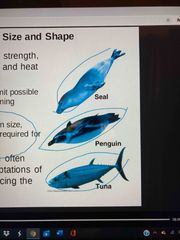
Physical laws govern strength, diffusion, movement, and heat exchange -Water properties limit possible shapes for fast swimming (all torpedo shape fish) -as animals increase in size, need thicker skeletons Convergent evolution=similar adaptations facing same challenge |
|
|
Exchange with environment |
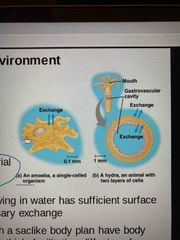
Nutrients, waste products, gases exchange across cell membranes Rate of exchange is proportional to an cells surface area Amount of exchange material is proportional to a cells volume ie: think of small city to put trash at edge of city, not bad. But if the city is larger, it would hard to put it all at the edge |
|
|
Multicellular organisms with a saclike body plan.. |
Have body walls that are only two cells thick facilitating diffusion of materials |
|
|
When the volume gets larger.. |
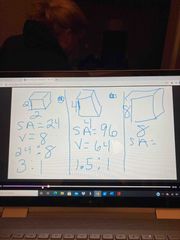
surface area does not get bigger, ratio stays small |
|
|
Cells in flat animals |
On direct contact with their environment Like tape worms |
|
|
More complex organisms are composed of compact masses of cells with |
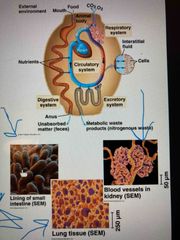
Complex internal organization Evolutionary adaptations enable sufficient exchange with the environment (branch or folded) |
|
|
Interstitial fluid |
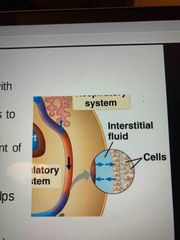
Fluid in Space between cells Links exchange surfaces to body cells allows movement of material into and out of cells |
|
|
A complex body plan helps an animal living in a variable environment to.. |
Maintain stable internal environment |
|
|
Hierarchical organization of body plan |
Tissues are composed of multiple cells Organs are made up of tissues Organ systems are made up of organs Some organs belong to more than one organ system (pancreas) |
|
|
Organ systems |
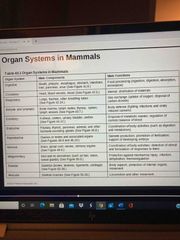
A |
|
|
4 types of animal tissues |
1. Epithelial 2. Connective 3. Muscle 4. Nervous |
|
|
Epithelial Tissue |

Covers the outside of the body Lines the organs and cavities within the body Contains cells that are tightly joined (tight junctions) |
|
|
Shapes of epithelial cells |
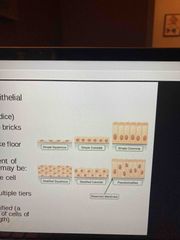
Cuboidal: like dice Columnar: like bricks Squamous: like floor tiles |
|
|
Arrangements of epithelial cells |
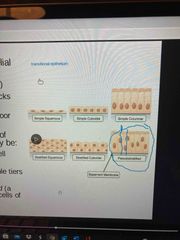
Simple: single cell layer Stratified: multiple tiers Pseudostratified: single layer of varying lengths Transitional: special type of stratified (layered) but each cell changes and stretches like in the bladder |
|
|
Epithelial tissue has polarity |
Has bottom-basal surface Has top-apical surface touches the lumen (which is the space of anything) |
|
|
Connective tissue |
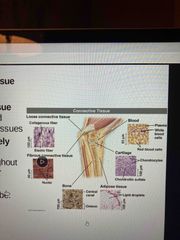
Binds and supports other tissues Contains sparsely packed cells scattered throughout an extra cellular matrix ( matrix can be liquid, jelly, or solid) |
|
|
3 types of connective tissue fibers (all made of protein) |
Collagenous fibers: strength and flexibility Reticular fibers: join connective tissue to adjacent tissues Elastic fibers: stretch and snap back to their original length (like a rubber back) ie: if you pull skin in back of hand, reticular allows you to stretch, while elastic returns it back to normal |
|
|
Connective tissue contains cells |
Fibroblasts: secrete protein of extra cellular fibers Macrophages: involved in the immune system ( in tissue cleaning up dead cellls and bacteria) |
|
|
1 of 6 types of connective tissue |
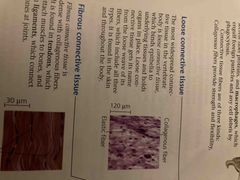
1. Loose connective tissue: binds epithelial to underlying tissues and holds organs in place |
|
|
2 of 6 connective tissues |
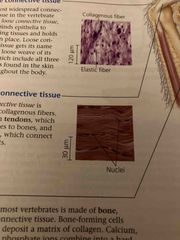
Fibrous: found in tendons which attach muscles to bones and ligaments which connect bones to joints |
|
|
3 of 6 connective tissue |
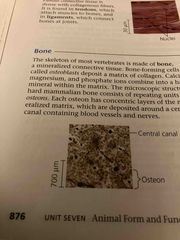
Bone: mineralized and forms skeleton |
|
|
4 of 6 connective tissue |
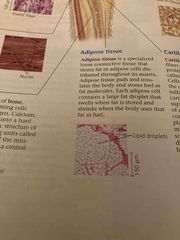
Adipose: tissue that stores fat for insulation and fuel |
|
|
5 of 6 connective tissue |
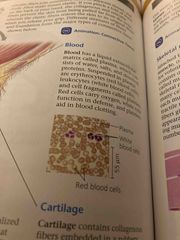
Blood: liquid matrix Composed of blood cells and cell fragments in blood plasma |
|
|
6 of 6 connective tissue |
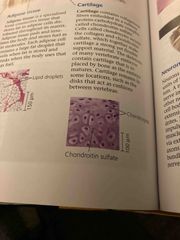
Cartilage: strong and flexible support material |
|
|
Muscle Tissue |
Responsible for nearly all types of body movement Muscle cells consist of filaments of the protein actin and myosin which together enable contractions |
|
|
3 types of muscle |
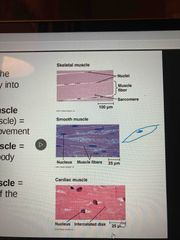
Skeletal: striated muscle. Voluntary movement Smooth: involuntary body activity Cardiac: contraction of the heart |
|
|
Nervous tissue |
Functions in the receipt, processing, and transmission of info Neurons: transmit nerve impulses Glial: support cells |
|
|
Coordination and control within a body depend on... |
Endocrine and nervous system |
|
|
Endocrine system |
Releases signaling molecules (hormones) into the bloodstream where cells with the corresponding receptor can receive the signal |
|
|
Hormones |
Can affect one or more regions throughout the body ie: thyroid hormone only talks to thyroid which release new hormones Relatively slow acting but can have long lasting effects (they take seconds) |
|
|
Nervous system |
Transmit info btw specific locations Info conveyed depends on the pathway, not the type of signal Nerve signal transmission is fast |
|
|
Both endocrine and nervous system work close together |
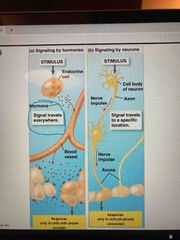
A |
|
|
Faced with environmental fluctuations, animals manage their internal environment by... |
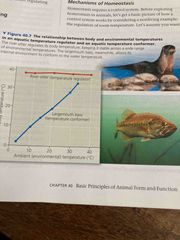
Regulating or conforming May regulate some environmental variables while conforming to others ie: fish may conform to surround temps but regulate its blood concentration |
|
|
Regulators |
Use internal control mechanisms to control internal change in the face of external fluctuation |
|
|
Conformers |
Allow its internal condition to vary with certain external changes Does not mean you are happy with big fluctuations. ie: tropical fish need specific temps |
|
|
Homeostasis |
Used by organisms to maintain a steady internal balance regardless of the external environment In humans: body temp, blood pH, glucose concentration maintain at constant level |
|
|
Mechanisms of homeostasis |
Set point: determines what the stimulus is Stimulus: falling above or below the set point Sensor: detects the stimulus Response: restores set point. |
|
|
Feedback control in homeostasis |
Negative feedback: returns a variable to normal range, what most rely on. Reduces stimulus Positive feedback: amplifies a stimulus and does not contribute to homeostasis in animals (blood clotting and “emptying containers”) ie: uterus needs to contract, more pressure increases contractions and pressure |
|
|
Circadian rhythm |
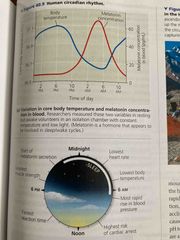
Governs physiological changes that occur roughly every 24 hours Alterations in homeostasis: set points and normal ranges can change with age or show cyclic variation |
|
|
Acclimatization |
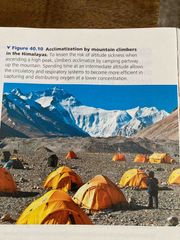
Alterations to homeostasis Can adjust to changes in external environment A temporary change during animals lifetime ie: high altitude=less O2, increases breathing. This causes increase in CO2 which then increases pH in blood. Kidneys release more alkaline molecules in urine to restore blood pH. |

